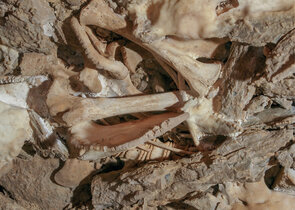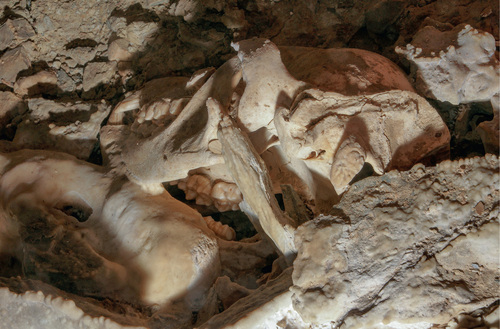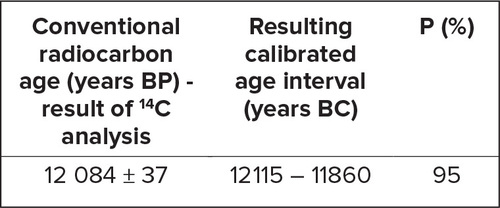Nature Conservation 2023 — 5. 6. 2023 — Research, Surveys and Data Management — Print article in pdf
A Prehistoric Bear Cub from the Javoříčko Karst

Every cave represents a unique natural phenomenon, preserving the complex links between living and non-living nature. They often contain paleontological findings as well as archaeological monuments connected with the development of the humans. The remains of animals get into the caves through the sinking of debris and alluvium. Some animals use caves for hibernation, others as shelters, dens, and food stores. And some find death underground after being caught in a natural trap...

Cranial view of the skull. © Ivan Balák
Discovery after a hundred years
In 1918 a subtle entrance into a small cave was discovered in a small limestone islet in the Javoříčko Karst (Central Moravia) during stone quarrying. The entrance caught the attention of a group of speleologists from the Ludmírov-Štymberk Czech Speleological Society Local Chapter, which, almost a hundred years after the discovery of the entrance (sometime around 2017), gradually dug through the amount of deposited cave sediments with the aim of disco-vering a way forward. Their efforts were rewarded at the end of July 2019, when they advanced to a small dome with a length of about 9 m, a width of about 1.5 m, and an average height of about 8 m. The small dome contains a relatively rich stalactite decoration represented mainly by stalactites and corallite forms, which also cover the walls of the chimney. Its base is covered with sharp-edged debris, probably of frost origin; clay cave sediments are essentially missing there. The debris is strengthened by sinter flow with the accompanying formation of small lake forms, cave pearls, and similar shapes.
In addition to the cave decoration, however, the newly discovered area also contained skeletal remains, of which the skeleton of a larger vertebrate caught attention at first glance. It was clear from the first photographs that it was the preserved skeleton of an as yet unspecified carnivore lying in a natural position on the debris floor. At the end of August 2019, palaeontologists with experience of studying caves were introduced to the find. They determined the bones of the larger mammal to be a juvenile Brown bear (Ursus arctos ssp.) about one year old. The original assumption that it was one of the species inhabiting the caves – the Cave hyena (Crocuta spelaea) or some form of the Cave bear (Ursus ex group spelaeus) – was not confirmed, but the finding did not lose its significance.
The question of age
Identification of the finding as a brown bear cub raised the question of the time of its origin. In the Czech Republic, the species Ursus arctos was found in various forms (subspecies) from the Pleistocene to historical times; the original estimate of the age of the finding ranged from hundreds of years to thousands of years. A rib sample (the only free fragment of about 3 cm long that was not covered or cemented with sinter) was taken from the skeleton for age determination using the radiocarbon method. This sample was handed over to the Czech Radiocarbon Laboratory at the Nuclear Physics Institute of the Czech Academy of Sciences, public research institution., with whom the Cave Administration of the Czech Republic has been cooperating for a long time.
Collagen was isolated from the sample, which was subsequently graphitized. Measurement was then carried out on the MICADAS compact tandem accelerator in HEKAL ATOMKI HAS laboratory in Debrecen (DeA). The resulting 14C activity and its combined uncertainty were expressed in years BP (Before Present) according to the Stuiver Polach Convention0for reporting radiocarbon determinations. The IntCal20 calibration curve designed for dating terrestrial samples of the Northern Hemisphere was used to calibrate the activity. The resulting calibrated age interval (dating result) was expressed in years BC (Before Christ) together with the absolute probability P (%) of this interval.

The dating results show that the age of the skeleton falls into the Upper Pleistocene period, also now as the Late Pleistocene, i.e. the very end of the Last Ice Age (Last Glacial Period). This is also evidenced by the sharp-edged frost debris at the bottom of the cave space on which the skeleton lies. The subsequent covering of the skeleton and floor debris with sinter material resulted from younger climatically warmer periods with abundant rainfall.
A survey of sediments, the cave topography, knowledge of the age of the deceased animal, and position of the skeleton all allows to idea of how and why the bear got into the cave and why it has been preserved as it is. The place with the described finding is located approximately 6 m below the level of today's entrance. The skeleton is on the surface of sharp-edged debris, partly covered by debris. The animal lies on its right side in a crouched position. Both the skeleton and the debris are completely cemented together with sinter coating, just like the entire invert level of the dome. The bones show no visible signs of injury or damage.
At the end of the Pleistocene, the Brown bear was the only member of the bear family in what is now the Czech Republic; cave bears no longer existed there. Even "non-cave" bears are currently looking for underground spaces including karst caves to spend the winter there, but unlike cave bears, their preferred wintering grounds are smaller cavities. Their fossil and recent dens are usually found closer to the entrance; bones or skeletons are not found there in large numbers.
Diagram of the bones of a bear cub. © Ivan Balák
Young individuals (born during the first winter season) usually spend the second winter season with or near their mother, but this is not always the case. The age of the animal found corresponds to the second winter. It is not possible today to determine whether the cub entered the cave with its mother and separated inside, but the authors consider it improbable. Rather, it was looking for a separate wintering place, wandering away from the mother, or simply the curiosity of the young. The cave could have been a natural trap (falling into a chasm from which the bear could not get out and died of hunger and thirst, sudden closing of the entrance, not finding a way back, it could have crawled into the cave through a narrow corridor that was not passable in the back direction, or perhaps a combination of several factors mentioned). It is equally probable that the death could have occurred simply from hunger, cold or disease, so the cave would not have been a real trap at all, it would have been a simple shelter. After the death of the cub, it remained in its original position, the visible bones do not display traces of serious injury (for example, a fracture), the bones were not dragged by another animal and they are not bitten. This fact supports the hypothesis that there may have been a sudden closure of the entrance, for example by a sediment slide, which prevented the presence of other predators and scavengers.
As part of the documentation, the immediate surroundings of the cave were also explored in detail. Several other fallen and collapsed cave entrances and the probable place where the karst chimney exited to the surface were recorded. The original natural entrance to the cave with the finding is unknown and has probably been filled with sediment.
A valuable finding
Speleological activities were immediately interrupted after the initial evaluation of the finding, the cave was closed with a lockable grate and other interventions aimed at protecting and recognizing the exceptional finding were made. The finding of the sinter cemented skeleton remains in place; it is protected from mechanical damage. The entrance to the cave is locked (the cave and its immediate surroundings are protected according to the Act on Nature Conservation and Landscape Protection) and entry is allowed only to speleologists who are conducting further speleological research there, and to relevant experts. It is possible that other interesting findings will be made in the debris filling.


